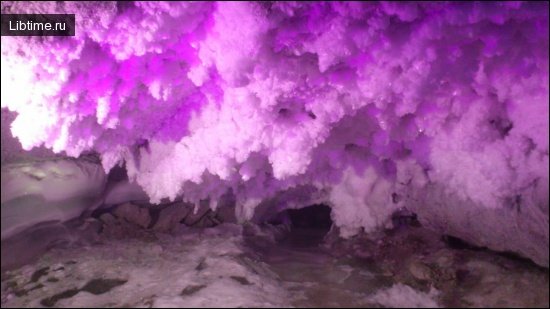East European speleological country
The East European speleological country, territorially coinciding with the Russian Plain, is characterized by a significant distribution of karst caves confined to carbonate and halogen rocks of Paleozoic, Mesozoic and Cenozoic age.
The largest in length caves in the USSR are located here. Karst caves are most widely spread in the Valdai-Kuloisky, Kamsko-Middle Volga, Pre-Caspian and Dniester-Black Sea speleological regions. 
In the Dvinsko-Mezenskaya province 84 karst caves have been investigated. The largest of them are Leningradskaya (3100 m), Severyanka (2500 m), Pinezhskaya (2300 m), Golubinskaya (1150 m) and Kulogorskaya (1028 m).
The Leningradskaya Cave is located on the left bank of the Sotka River. It was formed in the thickness of sulfate (gypsum and anhydrite) rocks of the Lower Permian and represents the bed of an underground river. The largest grottoes reach a height of 18 meters. The total length of the cave is 3100 m and its volume is 73 000 m 3.
There are three speleological provinces in the Kamsko-Srednevolzhskaya region: Ufimsko-Kamskaya, Dema-Ufimskaya and Srednevolzhskaya. About 90 karst caves have been investigated in the Ufa-Kama province, mostly confined to sulfate rocks of Permian age.
The largest of them are Kungurskaya cave (5600 m long), Zuyatskaya (900 m), Nizhnemikhailovskaya II (721 m), Kichmenskaya (460 m), Uinskaya (400 m) and Bolshaya Mechkinskaya (350 m). 
The Dema-Ufim province covers the eastern edge of the Russian Plain adjacent to the Southern Urals. About 70 karst caves have been described here, mostly confined to Permian gypsums. The largest of them are Kueshta (571 m long), Bolshaya Kurmanaevskaya (500 m), Okhlebininskaya (200 m), Karlamanskaya (198 m) and Malaya Kurmanaevskaya (100 m).
The Pre-Caspian region covering the Pre-Caspian lowland is subdivided into two speleological provinces: West-Prikaspian and East-Prikaspian.
Several karst caves have been explored in the West-Prikaspian province. The largest of them, the Big Baskunchak cave, is located on the northwestern shore of Lake Baskunchak, in the Ak-Dzhar gully. It consists of several grottoes and passages, as well as a number of side branches ending in narrow cracks. The total length of the cave is 350 m.
The caves of the East Pre-Caspian province are poorly explored. Small cavities have been noted in the Indersky uplift, where they are developed in salt and gypsum deposits of Permian age.
Within the Dniester-Black Sea region, caves are most widespread in the Pridnestrovian speleological province, which covers the southwestern edge of the Russian Plain.
Currently, 26 caves have been explored here, including the world's greatest gypsum caves Optimistic (92 000 m long), Ozernaya (80 100 m), Kryvchenska (18 785 m), Mlynki (14 120 m), Verteba (7820 m) and Ugryn (2200 m), which are located in Podolia on the interfluve of the left tributaries of the Dniester Seret and Zbruch. 
The only exception is the Ozernaya cave, where galleries opening the aquifer were found. The air temperature in the caves varies from 8.2 to 12.5°, relative humidity from 80 to 100%.
Although the caves were formed in gypsum, many of them contain calcite natellas confined to zones of disturbance of chemogenic limestone overlying gypsum. In some galleries of caves there are autochthonous gypsum crystals of various shapes, sizes and colors.
Optimistic, Ozernaya, Kryvchenskaya and Mlynki caves occupy a special position among the caves of the Transnistrian province.


